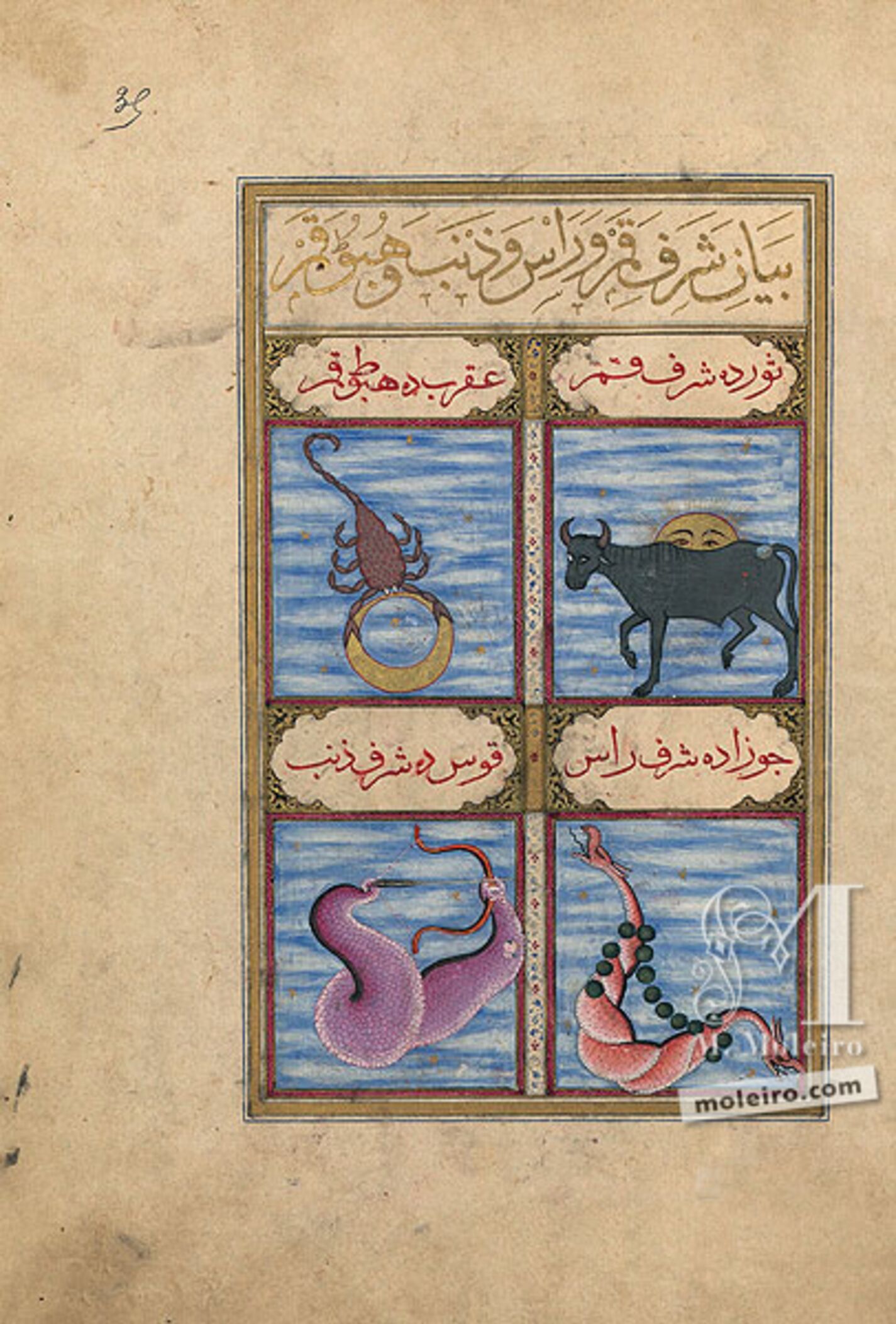These four consecutive pages deal with the images of the exaltation, or apogee (sharaf) and dejection, or perigee (hubut), of the seven traditional planets and of the Lunar Node (see also f. 24v). Apogee and perigee are astronomical terms that define the points most distant from and closest to the earth, especially in reference to the elliptical orbit of the Moon or a man-made satellite rotating around Earth. In astrology, exaltation and dejection have the general meaning of the point of maximum or minimum influence of a planet in association with one of the constellations or, in pictorial terms, with one of the signs of the zodiac.
Each page has four vignettes with a title written in red ink inside a cloud-shaped cartouche. The general title in gold ink above reads simply, “The Demonstration of the Exaltation and Dejection of …” followed by the name of the two planets depicted underneath. The background behind the cartouches and between vignettes is richly ornamented with tiny coloured flowers and scrolls against gold or white. The simple solution the painter found to illustrate the contrast between exaltation and dejection was to depict the planet upright for the former and, for the latter, upside down in close association with the sign of the zodiac against the backdrop of a cloudy sky in keeping with the iconography found in the Treatise of Nativities (ff. 8v-32v). Thus, the two vignettes on the upper half of f. 33v deal with Saturn’s exaltation in Libra (the scale) and dejection in Aries (the ram). On the lower half are Jupiter’s exaltation in Cancer (the crab) and dejection in Capricorn (the goat). The opposite page (f. 34r) illustrates Mars’s maximum influence in the sign of Capricorn and minimum in Cancer and those of the Sun in Aries and Libra, thus reversing the images of Jupiter and Saturn, respectively, from the previous page.

These four consecutive pages deal with the images of the exaltation, or apogee (sharaf) and dejection, or perigee (hubut), of the seven traditional planets and of the Lunar Node (see also f. 24v). Apogee and perigee are astronomical terms that define the points most distant from and closest to the earth, especially in reference to the elliptical orbit of the Moon or a man-made satellite rotating around Earth. In astrology, exaltation and dejection have the general meaning of the point of maximum or minimum influence of a planet in association with one of the constellations or, in pictorial terms, with one of the signs of the zodiac.
Each page has four vignettes with a title written in red ink inside a cloud-shaped cartouche. The general title in gold ink above reads simply, “The Demonstration of the Exaltation and Dejection of …” followed by the name of the two planets depicted underneath. The background behind the cartouches and between vignettes is richly ornamented with tiny coloured flowers and scrolls against gold or white. The simple solution the painter found to illustrate the contrast between exaltation and dejection was to depict the planet upright for the former and, for the latter, upside down in close association with the sign of the zodiac against the backdrop of a cloudy sky in keeping with the iconography found in the Treatise of Nativities (ff. 8v-32v). Thus, the two vignettes on the upper half of f. 33v deal with Saturn’s exaltation in Libra (the scale) and dejection in Aries (the ram). On the lower half are Jupiter’s exaltation in Cancer (the crab) and dejection in Capricorn (the goat). The opposite page (f. 34r) illustrates Mars’s maximum influence in the sign of Capricorn and minimum in Cancer and those of the Sun in Aries and Libra, thus reversing the images of Jupiter and Saturn, respectively, from the previous page.